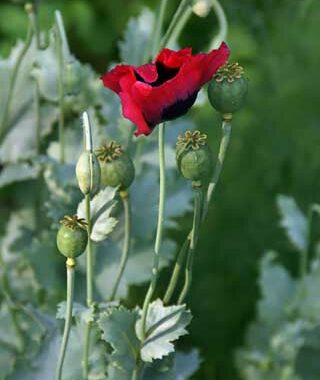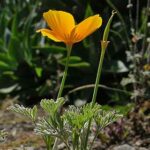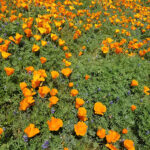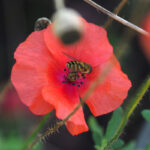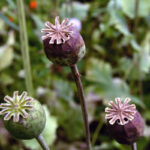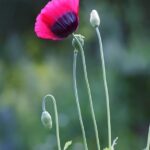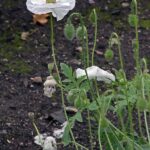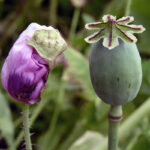Common poppy resembles its relative long-headed poppy (P. dubium), but they can be most easily differentiated on the basis of the form of the fruit of their capsule. There are also small differences in the hairiness of the stem and, in the size and colour of the corolla. Common poppy is the national flower of Poland.
Oriental poppy can be easily confused with pseudo-oriental poppy (P. pseudoorientale), which is also commonly cultivated in gardens. The best identification markers for Oriental poppy are the way its leaves only reach halfway up the stem, its nodding buds, its usually purely orange petals and its conical capsule. The showiest compound-flowered varieties are not necessarily instantly recognizable as poppies. Unlike some other poppy species, Oriental poppy has no medicinal properties.
Opium poppies do not grow ferally at all in Finland – it has probably been developed in the eastern Mediterranean areas from the species Papaver setigenum. Opium poppy is normally cultivated in Finland as an annual ornamental. It is also quite often a casual or semi-regular escape in places that have been culturally impacted, such as old gardens and earth heaps.
Opium poppy varies quite a lot. The best identifying features are its often many-flowered inflorescence, at most usually only slightly lobed leaves, and the form of the capsule. The number of the rays of the stigma disc on top of the capsule is a much-used marker in classifying poppies, but it has been noted that it varies a lot according to circumstance.
Acclaimed and maligned in equal measure, the opium poppy is an old medicinal plant whose latex-like sap includes many alkaloids, the most important of which are morphine, codeine and papaverin. Opium is used medicinally to relieve pain, as a cough medicine and to treat diarrhea. Apart from being an important medicinal plant, opium poppy is also used as an illicit drug. The ornamental opium poppy’s latex has no narcotic value. There are no alkaloids in the seeds, but their oil is used for flavor in baking, and the whole seeds may be used for decoration.
캘리포니아에서 제일 많이 볼수 있는 캘리포니아의 꽃 양귀비… 이곷은 관상용 양귀비아다. 일명 개양귀비…사실은 이 파피꽃도 동양의 양귀비꽃처럼 약용으로 쓸모가 있을까해서 보러갔는데…
우리가 흔히 보는 양귀비는 ‘꽃양귀비’ 또는 ‘개양귀비‘라고 불리는 관상용이다. 양귀비는 5~6월에 핀다. 흔히 볼 수 있는 개양귀비는 ‘우미인초’라고도 한다. 옛날 중국 한나라 유방과 치열한 전투를 벌였던 초나라 항우의 연인이 우미인(우희)이다. 항우만을 사랑했던 가련한 여인 우미인. 그녀는 항우가 유방의 군대에 포위되자 자신 때문에 탈출에 방해가 되지 않기 위해 자결한다. 그 후 우미인의 무덤에서 핀 한 송이 꽃이 개양귀비다. 항우와 우미인의 애절한 사랑이야기는 중국에서 가장 유명한 경국 ‘패왕별희’의 소재다.
그리고, 약용으로 쓰이고 있는 양귀비의 유래는 당나라 현종의 여인의 이름이다. 양귀비의 이름은 ‘옥환(玉環)’ 귀비라는 뜻은 ‘황비(후궁)’의 순위를 나타내는 칭호다. 성이 양씨기 때문에 양귀비로 불렸다. 양귀비는 경국지색이라는 말을 탄생시킬 만큼 아름다운 여인이었다. 시대를 풍미했던 양귀비는 자결이라는 불행한 최후를 맞는다.
두 절세미인은 모두 자결했다. 하지만 나라를 망하게 한 양귀비는 아편의 재로가 되는 양귀비꽃에 이름을 남겼고 한결같이 항우만 사랑한 우미인은 아편이 없는 꽃양귀비에 이름을 남겼다.


